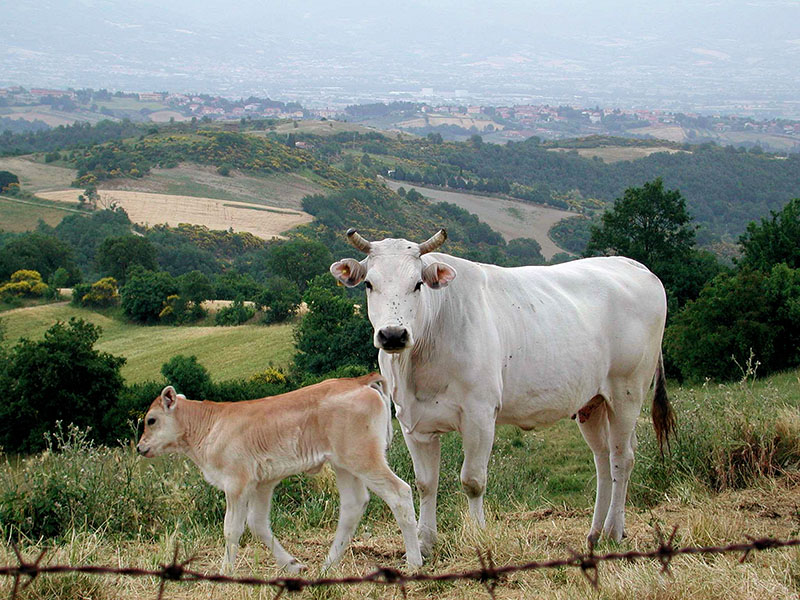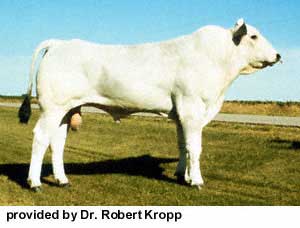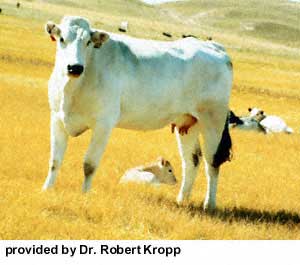Chianina Cattle
The Chianina (pronounced kee-a-nee-na) may well be one of the oldest breeds of cattle in existence. They were praised by the Georgic poets, Columella and Vergil, and were the models for Roman sculptures.
The breed originated primarily in the west central part of Italy and was found in a wide variety of environmental conditions. Because of this, the cattle vary in size and type from region to region. The largest representatives of the breed, from the plains of Arezzo and Siena, have supplied most of the foundation stock that has been used in the United States and Canada. The name comes from the Chiana Valley in the province of Tuscany in Central Italy.
Until recent times the Chianina were used primarily as draft animals in their homeland. With the advent of modern mechanized farming practices they selection emphasis has been placed on the breeds ability to produce beef. The earlier selection for work animals had produced a very large breed with considerable length of leg, good action, and heavy muscling. Good dispositions were also desired in the draft animals. The later selections for beef production has maintained the size of the breed and improved the rate of growth.
U.S. servicemen, stationed in Italy during World War II, discovered Chianina. In 1971, Chianina genetics were introduced to the U.S. when the first semen was imported from Italy. Diaceto I was the first Italian fullblood bull to be collected. The first Chianina born in the U.S. was a black half-blood Chianina x Angus/Holstein bull calf. He was born January 31, 1972, at the Tannehill Ranch, King City, CA.
For the first few years, Chianina genetics were attainable only through semen. United States Department of Agriculture regulations prohibited the importation of cattle from countries having Foot and Mouth disease, and Italy was one of those countries. A private quarantine station was established in Italy where semen was collected, processed and shipped to breeders in the U.S. For a one year period, 17 young Chianina bulls were admitted and their semen collected.
Another avenue for obtaining fullblood Chianina semen was from Canadian breeders. Although Italian Chianina were not allowed to move into the U.S. from Canada, U.S. breeders could import semen. In 1973, Italian fullblood Chianina were exported from Canada into this country.
Physical Characteristics
Fullblood Chianina have short hair that varies from white to steel gray in color. Bulls are often a darker gray around their front ends. Both sexes have black pigmented skin, points and mucosa. The short horns curve forward and are usually black in the younger animals but become lighter, beginning at the base, as the animals mature.The most noticeable characteristic of the breed is the extensive and well-defined muscling. The shoulders, back and rear quarters are especially well formed. The legs are longer than most breeds and the bodies are not proportionally as long as some breeds that have shorter legs. The faces are rather long and straight. These characteristics give a distinctive appearance
The breed is often referred to as a "terminal" breed by cattlemen. This infers that the primary use of the breed is as the sire to animals which will all be marketed. The herds they are used in are frequently crossbred and the Chianina bulls provide an outstanding growth rate in the offspring of these crossbred females.
Cows of the breed often have small udders and are not noted for their milk production. This is not surprising as they were originally valued for draft and later for meat production.
Registries and Breed Associations
United States
American Chianina Association
P.O. Box 890
Platte City, MO 64079
Phone: (816) 431-2808
References
Briggs, H.M. & D.M. Briggs. Modern Breeds of Livestock. Fourth Edition. Macmillan Publishing Co. 1980
Mason, I.L, World Dictionary of Livestock Breeds, Third edition (1988), C.A.B International
Promotional materials from American Chianina Association, Platte City, MO provided by Dr. Michael L. Thonney, Professor of Animal Science, Cornell University



